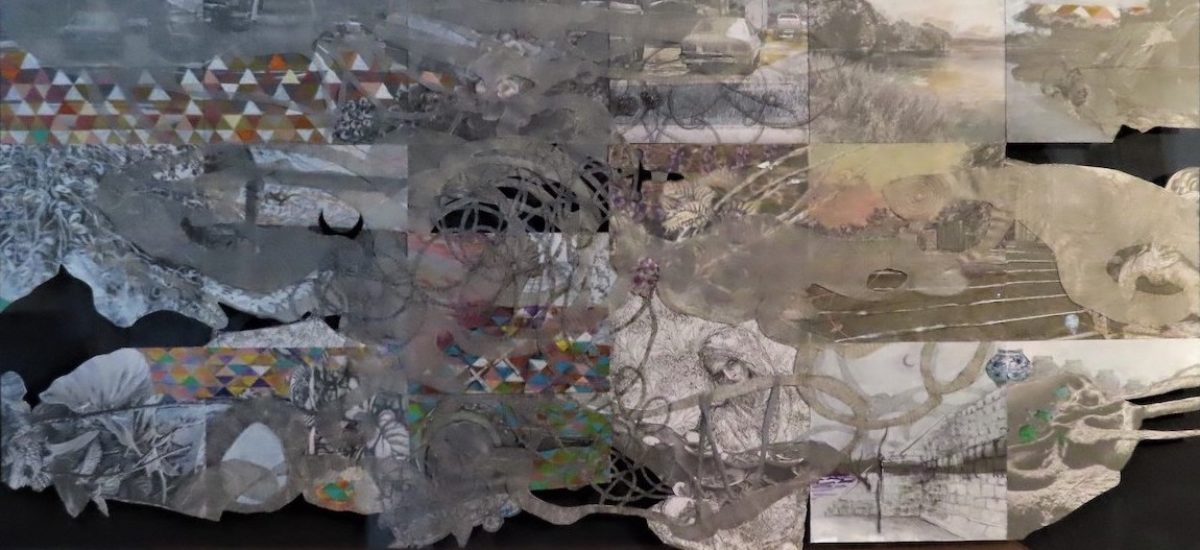Photo courtesy of Layla Gonaduwa
For three months Layla Gonaduwa, a self taught, interdisciplinary artist, travelled around Sri Lanka to explore the concept of memory, home and migration. She explored symbiotic and discordant relationships between within communities and ecosystems.
“The travelling was done away from the obvious urban suburbs and main towns, but in areas with less focus; the stories that appeared were multi layered and took on varied directions that are not directly linked or thought of in terms of migration and movement. I myself explored the concept of Home, both literally and metaphorically and at times came across situations of alliance which were two way mutually favourable mechanisms. One constant observation on translocation and migration was that successful integration is never far away from conformity and loss of identity,” Layla wrote in a blog post.
The result of her travels and observations is an exhibition at the Barefoot Gallery later this month. The exhibition, called Facing Maha, will feature mixed media work. Here is an interview with Layla.
How did the project for Pro Helvetia come about and what is its purpose?
It is a residency program awarded to three Asian artists each year by the Swiss Arts Council. Initially I was supposed to be in Basel and my idea for the concept was in the form of memory and ongoing dialogue with regard to migration with the Swiss nationals residing in Sri Lanka and the Sri Lankans living in Switzerland. But with travel restricted for Covid, the Asian artists were given the option of a home country residency. I reconfigured the concept to suit this unexpected situation. My plan was to stay at each place for a couple of weeks, be open to situations that arise and stories that will spring up. There was no effort and attempt to create but just to observe and listen. There was never any guarantee how successful this was going to be but such is the process.
Our country at the moment seems fraught with division and fracture. During your travels around the country what did you find about how people are interacting?
It was a three month journey. It is hard to generalize. With the curiosity that comes with a visitor in the midst, conversations do happen, offers of help and suggestions do come about, more so than what I have experienced overseas; that is typical to Sri Lanka. But there also seeps in a feeling of veiled suspicion and distrust of strangers that perhaps is fanned over decades of partisan politics. Having said that, what I felt most was the idea of a local woman travelling alone was still very bewildering and disturbing.
Do the Tamil and Muslim people you met see Sri Lanka as their home?
My experience was that they do but there is a sense of clannishness among them because of the insecurities created, at times apprehension at the thought of freely moving about, away from their comfort zone. I met a young Muslim man from a humble background in the hills, far away from his hometown, doing great things for the village he has made home because he fell in love with the mountains. But he is frustrated that, despite living there for years and being a tremendous source of help and inspiration to the community, he is still considered a stranger and in certain situations not included in the conversation. Whether the divide is ethnic or geo political, it’s hard to say because both do exist from what I saw.
Have people in general been welcoming to others of different ethnicities and religions?
They are welcoming to a visitor. Whether long term settlements work the same way is doubtful in some areas. This I found within all ethnicities. There is a sense of propriety area wise and people belonging to another ethnicity or religion coming in is not looked upon favourably. The contributions – even positive ones – might be viewed with resentment and in some cases jealousy.
How can people assimilate and integrate without losing their own culture?
We are creatures of habit and anything challenging or new can create concern and disturbance. Instead we need to consider it as an enrichment rather than a decline or de-enhancement of a culture. This takes bold conversations and steps to challenge the standard narrative and it has to happen at grassroot level and early childhood. Surely we can enjoy the differences together with the similarities? Cultural evolution is integral to human evolution. Culture is not a static state but rather fluid. I fail to see how one can “lose” their culture; it can only evolve and it is inevitable.
How are people interacting with the environment especially since we hear stories every day of destruction on a large scale?
My days at Pitawalapathana were very telling. The villagers and wardens would clean up, cursing the visitors. The local visitors would arrive and despite signage and facilities for proper disposal, would pay no heed. There are resettlements of entire villages at the whims of politicians and votes and in one case I came across, a foreign NGO with no proper study and research. The human-elephant conflict is escalating, there is mass deforestation, water tables are drying out and livelihoods are lost or declining due to no relationship or understanding about the new territory. This has been happening under every government and now it is worse and out of control. Poverty drives most people without feasible, practical alternatives. Greed drives the others. Yet I came across younger people who were more attuned to their surroundings and taking a stand. The key is creating awareness at a very young age, getting them actively involved with their surroundings.
How did your travels impact on your art, has it changed the way you see things?
I am an artist who works through real life experiences, so it was no different to the past collections. Travel always opens me to a more comprehensive, multi-faceted, layered, realistic picture. I am flexible in shedding pre-conceived notions and theories at times are ingrained in us. Change is constant and I have no apprehension. The works in this collection have no careful curation. No colour palette. There are photo collages fighting to form some sort of reasonable landscape. There are sculptures metamorphosing and spreading from unlikely places. Wood carvings of non-native flora negotiating positively or negatively side by side a very valuable native mee tree. It represents the ethos of multiculturalism with all its permutations and dilemmas. Paintings of people and stories I came across. “The length of your limbs, the width of your cloth” drawings show the idea of “home” is not always that clear cut. My own life path leads me somewhere else right after the first day of this exhibition and “home” might cease to mean something tangible to me. All these competing works may fall into a harmonious state. Who knows?
How did your travels change you personally?
Travel has always been my catharsis after art. It is transformative.
How physically taxing were the actual journeys?
It was more of a mentally taxing exercise. Imagine a refugee or a migrant constantly trying to fit in. Altering, adjusting, lying low, trying to make a mark, trying not to bring attention, trying to take root, creating a safe comfortable space called home….


